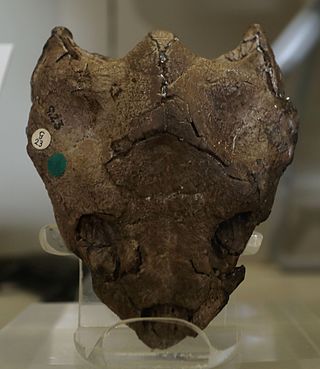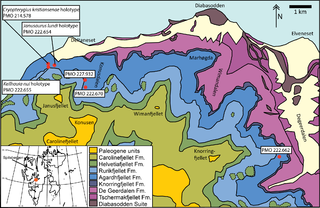The Cretaceous is a geological period that lasted from about 145 to 66 million years ago (Mya). It is the third and final period of the Mesozoic Era, as well as the longest. At around 79 million years, it is the longest geological period of the entire Phanerozoic. The name is derived from the Latin creta, "chalk", which is abundant in the latter half of the period. It is usually abbreviated K, for its German translation Kreide.
Gerhardodon is an extinct genus of mammal from the Lower Cretaceous of southern England. It was a member of the also extinct order of Multituberculata, and lived with such dinosaurs as Iguanodon. It lies within the suborder "Plagiaulacida" and family Pinheirodontidae.
In the geological timescale, the Berriasian is an age/stage of the Early/Lower Cretaceous. It is the oldest subdivision in the entire Cretaceous. It has been taken to span the time between 145.0 ± 4.0 Ma and 139.8 ± 3.0 Ma. The Berriasian succeeds the Tithonian and precedes the Valanginian.

Goniopholis is an extinct genus of goniopholidid crocodyliform that lived in Europe during the Late Jurassic and Early Cretaceous. Like other goniopholidids, it resembled living crocodilians, and probably had a similar ecology as semi-aquatic ambush predators.

Archaeopterygidae is a group of maniraptoran dinosaurs, known from the latest Jurassic and earliest Cretaceous of Europe. In most current classifications, it contains only the genera Archaeopteryx and Wellnhoferia. As its name suggests, Protarchaeopteryx was also once referred to this group, but most paleontologists now consider it an oviraptorosaur. Other referred genera, like Jurapteryx, Wellnhoferia, and "Proornis", are probably synonymous with Archaeopteryx or do not belong into this group. Jinfengopteryx was originally described as an archaeopterygid, though it was later shown to be a troodontid. A few studies have recovered Anchiornis and Xiaotingia to also be members of the Archaeopterygidae, though most subsequent analyses have failed to arrive at the same result. Uncertainties still exist, however, and it may not be possible to confidently state whether archaeopterygids are more closely related to modern birds or to deinonychosaurs barring new and better specimens of relevant species. Teeth attributable to archaeopterygids are known from the earliest Cretaceous (Berriasian) Cherves-de-Cognac locality and the Angeac-Charente bonebed of France.

Turiasauria is an unranked clade of basal sauropod dinosaurs known from Middle Jurassic to Early Cretaceous deposits in Europe, North America, and Africa.
The Lakota Formation is a sequence of rocks of early Cretaceous age from Western North America. Located in South Dakota, the name of the formation is derived from the Lakota Native American tribe.

Berriasella is a discoidal evolute perisphinctacean ammonite, and type genus for the neocomitid subfamily Berriasellinae. Its ribbing is distinct, consisting of both simple and bifurcated ribs that extend from the umbilical seam across the venter; its whorl section generally compressed, the venter more or less narrowly rounded. The species Berriasella jacobi traditionally has been regarded an index fossil defining the base of the Cretaceous, however since 2016 this had been replaced by the first occurrence of Calpionella alpina. Some authors regard B. jacobi as instead belonging to the genus Strambergella.
Elosuchus is an extinct genus of neosuchian crocodyliform that lived during the Middle Cretaceous of what is now Africa.

Goniopholididae is an extinct family of moderate-sized semi-aquatic neosuchian crocodyliformes. Their bodyplan and morphology are convergent on living crocodilians. They lived across Laurasia between the Middle Jurassic and the Late Cretaceous.
Lusitanisuchus is an extinct genus of mesoeucrocodylian crocodylomorph. Mostly fragmentary fossils have been found from several localities in Portugal and are Late Jurassic and Early Cretaceous in age.
Paramacellodus is an extinct genus of scincomorph lizards from the Early Cretaceous of England and France, and the Late Jurassic of Portugal and the western United States. The type species, Paramacellodus oweni, was named in 1967 from the earliest Cretaceous (Berriasian) Purbeck Group in Dorset, England. Additional material referable to a species of Paramacellodus, possibly P. oweni, has been described from the Morrison Formation, specifically in Como Bluff, Wyoming, and Dinosaur National Monument, Utah. An indeterminate species is known from the Berriasian aged Angeac-Charente bonebed in France. Paramacellodus belongs to an extinct family of scincomorphs called Paramacellodidae, which spanned most of Laurasia during the Late Jurassic and Early Cretaceous and represented one of the earliest evolutionary radiations of lizards.

Dorsetochelys is an extinct genus of turtle from the Early Cretaceous of southern England and northwestern Germany.

Pleurosternon is an extinct genus of freshwater pleurosternid turtle from the latest Jurassic to earliest Cretaceous of Europe. Its type species, P. bullockii was described by the paleontologist Richard Owen in 1853. Since then, and throughout the late 19th century, many fossil turtles were incorrectly assigned to this genus, though only two are currently considered valid.

Pygope is an extinct genus of brachiopods belonging to the family Pygopidae. These brachiopods lived in open sea from the Jurassic Period, Kimmeridgian age up to Cretaceous Period, Barremian age. Some of the species are characterised by a smaller or larger perforation through the entire shell in older specimens, while others just have a depression somewhere on the midline. Younger specimens of the perforated species develop a heart-shape and subsequently both extensions merge, thus encircling a central passage which is in fact entirely outside the shell.

Leinkupal is a genus of diplodocine sauropod known from the Early Cretaceous of the Bajada Colorada Formation, southeastern Neuquén Basin in the Neuquén Province of Argentina. It contains a single species, Leinkupal laticauda.

The Agardhfjellet Formation is a geologic formation in Svalbard, Norway. It preserves fossils dating back to the Oxfordian to Berriasian stages, spanning the Late Jurassic-Early Cretaceous boundary. The formation contains the Slottsmøya Member, a highly fossiliferous unit (Lagerstätte) where many ichthyosaur and plesiosaur fossils have been found, as well as abundant and well preserved fossils of invertebrates.

Pleurosternidae is an extinct family of freshwater turtles belonging to Paracryptodira. They are definitively known from the Late Jurassic to Early Cretaceous (Albian) of Western Europe and North America.
Becklesius is an extinct genus of Paramacellodid lizard known from the Late Jurassic to Late Cretaceous of Europe, the type species, B. hoffstetteri is known from Kimmeridgian aged sediments of the Alcobaça Formation in Portugal. An indeterminate species is known from Berriasian aged sediments of the Lulworth Formation in the UK. Another species B. cataphractus is known the Barremian aged sediments of the Una locality, part of the La Huérguina Formation, Spain. A third species, B. nopcsai is known from the Late Cretaceous (Maastrichtian) Sânpetru Formation of Romania.

Coccolepididae is an extinct family of ray-finned fish, known from the Early Jurassic to Early Cretaceous, most of which were originally referred to the type genus Coccolepis. They had a widespread distribution, being found in North and South America, Australia, Asia and Europe. They are mostly known from freshwater environments, though several species have been found in marine environments. They are morphologically conservative, and have poorly ossified endo and exoskeletons, which usually results in poor preservation. This makes it difficult to distinguish species. They are generally small fish, with the largest known specimens reaching a length of 210 mm. Historically, they have been classified as members of “Palaeonisciformes”, a paraphyletic grouping of non-neopterygian fish, due to their plesiomorphic conservative morphology closely resembling those of many other groups of primitive fish. They have been suggested to be relatives of the Acipenseriformes within the Chondrostei.










